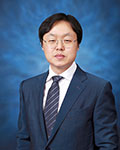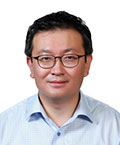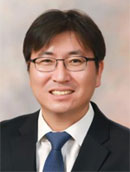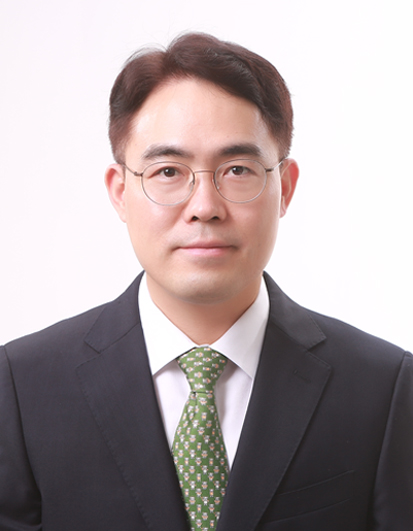PEOPLE
FACULTY
-
 Chung, In
Chung, In- Position: Associate Professor
- Major: Inorganic Chemistry
- Office: Building 302, Room 919
- E-mail: inchung@snu.ac.kr
- Tel: +82-2-880-7408
There are three major research topics in our laboratory. First, metal halide perovskite materials for optoelectronic applications such as photovoltaics, photodetectors, and light emitting diodes. The second is research on thermoelectric materials. Thermoelectric materials allow energy conversion between heat and electricity, thereby providing alternative routes for power generation and cooling. Third, studies on electronic correlations and magnetism in transition metal compounds are actively under way.
-
 Lee, Changha
Lee, Changha- Position: Associate Professor
- Major: Environmental Engineering
- Office: Building 302, Room 916 | Advanced Redox Technology Lab
- E-mail: leechangha@snu.ac.kr
- Tel: +82-2-880-8630
The major research goals of the Advanced Redox Technologies (ART) laboratory are to develop novel environmental remediation technologies (water treatment, air purification, disinfection, etc.) based on (photo) chemical reactions that are innovative, environmentally-friendly, and energy-efficient, and to study the fate and behaviors of emerging contaminants in natural media and treatment processes.
-
 Lee, Kyu Tae
Lee, Kyu Tae- Position: Associate Professor
- Major: Electrochemistry, Solid State Chemistry
- Office: Building 302, Room 812 | Electrochemical Energy System Lab.
- E-mail: ktlee@snu.ac.kr
- Tel: +82-2-880-9386
We are developing a new electrode material for rechargeable batteries for electric vehicles and portable electronic devices. Also, we are pursuing research to improve the cell performance of electrode material through synthesis of new electrode material, analysis of its electrode material, and electrochemical characterization based on electrochemistry and solid chemistry.
-
 Nam, Jaewook
Nam, Jaewook- Position: Associate Professor
- Major: Advanced Material Processing
- Office: Building 302, Room 917 | Microfluidics and Coating Process Laboratory
- E-mail: jaewooknam@snu.ac.kr
- Tel: +82-2-880-1654
Our goal is to perform creative research for analyzing and understanding transport phenomena through experiment, theory, and computation. We are particularly interested in developing novel numerical and experimental techniques to understand microscale flow phenomena with liquid/gas interfaces and particles. Through the fundamental understanding of such phenomena, we are aiming to design novel processes, in particular for the high-performance film production.
-
 Oh, Joon Hak
Oh, Joon Hak- Position: Associate Professor
- Major: Organic & Polymer Electronics
- Office: Building 302, Room 815 | Organic & Polymer Electronics Lab.
- E-mail: joonhoh@snu.ac.kr
- Tel: +82-2-880-8641
Our lab has mainly focused on synthesis of organic and polymeric nanomaterials and carbon nanomaterials, enhancement of their electrical and optical functions by controlling the physical and chemical features, and applications to flexible electronic devices and energy devices such as organic field-effect transistors, organic solar cells and chemical/bio/optical/pressure sensors.
We develop various types of organic and polymeric materials including semiconductor, conductor, insulator and dopant, and fabricate nanomaterials using self-assembly, templating, ink-jet printing and electrospinning as well as thin films, and pursue research to apply these to next-generation electronic devices.
Our goal is to develop highly efficient organic and polymeric electronic materials by systemic analysis on the charge transfer mechanism and the structure-property correlation, and finally, to develop original technology of organic and polymer-based electronic devices with higher electronic performance and operational/environmental stability -
 Park, Jungwon
Park, Jungwon- Position: Associate Professor
- Major: Physical Chemistry of Materials
- Office: Building 302, Room 813
- E-mail: jungwonpark@snu.ac.kr
- Tel: +82-2-880-2259
Our group focuses on studying physical and chemical reactions of nanomaterials by using multi-dimensional analytical approaches. We aim to elucidate structure-function relationship of nanomaterials from the fundamental level to the level of practical application. By combining in situ liquid phase TEM, ab-initio structure reconstruction method, and theoretical calculation, we correlate nanomaterial structures and their behaviors in catalyst, optical activities, and energy applications. We also study crystallization, interactions, and structures occurring in many systems of chemical engineering including polymers, colloids, nanoparticles, macromolecules, and biomolecules. Furthermore, we develop synthetic methods for low dimensional materials in catalysis, battery systems, and next generation electronic devices by utilizing in situ TEM to solve engineering issues relevant to their surfaces and interfaces.
-
 Seo, Sang Woo
Seo, Sang Woo- Position: Associate Professor
- Major: Systems and Synthetic Biology
- Office: Building 302, Room 727
- E-mail: swseo@snu.ac.kr
- Tel: +82-2-880-2274
We research in the fields of synthetic biology and systems biology. Particularly, we are interested in applying synthetic and systems biology approaches to elucidate and redesign complex regulatory networks of microorganisms i) for the production of chemicals, fuels, pharmaceuticals, and therapeutics, ii) for environmental bio-remediation, and iii) for biomedical applications.